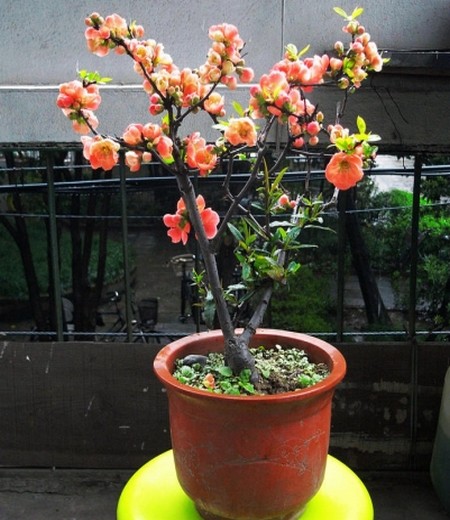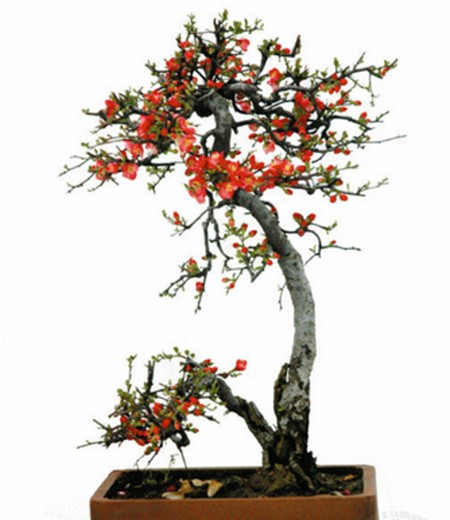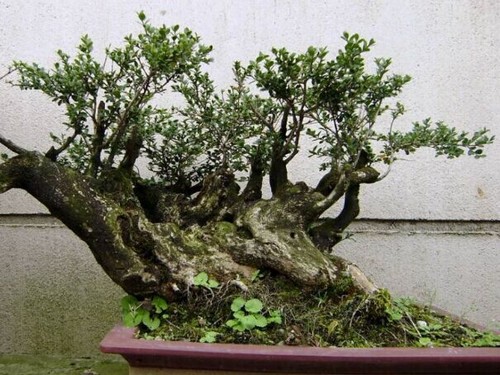The method of making bonsai of Begonia with stick stem
Paste stem begonia as a unique ornamental tree, embellished in the gardens and green space, a little red in the grass, it is probably such a beautiful scenery. It is colorful, let people never get tired of watching, but also enjoy it, its bonsai is usually placed in the hall, leisure places, but also can be reasonably matched with the building, oh, so that the beauty of the courtyard to add luster, more elegant and elegant.

[material selection and cultivation measures]
Artificial propagation: mainly by dividing plants, cutting and striping. Ramet should be carried out in early spring, the clump mother plant should be dug up by root, split with a sharp knife, and then be planted with 2-3 branches per plant, and then be divided 3-5 years after planting. There are two kinds of cuttings: hardwood cuttings and softwood cuttings: hardwood cuttings are carried out from February to March, the cuttings are 10 cm long and 15 cm long, and the cuttings are about 1B2 deep; softwood cuttings are carried out in the plum rain season from June to July, and the cuttings are easy to take root by mud cutting. Pressing can be carried out in winter or spring, opening a small trench beside the root, climbing branches to the ground, blocking it with fertile soil, and being able to take root by itself. After autumn, the rooting strips were cut off and separated from the mother plant, and then retransplanted in the following spring.
[process of putting on the basin]
Select basin: stick stem begonia often use deep rectangular or oval basin, square and round basin can also be used, cliff type is to use deep thousand-barrel basin. Purple sand pottery basin or glazed pottery basin is suitable for texture, and other textures are also available.
Use soil: the requirement of soil quality is not strict, either slightly acidic soil or neutral soil, but it is better to use loose, fertile and well drained rotten leaf soil or pastoral soil. When putting on the basin, the bottom of the basin is cushioned with sand or vermiculite to facilitate drainage.
Planting: both in spring and autumn, and the dormant period is suitable. Before planting, it is necessary to cut short thick roots and long roots, so as not to bend in the basin. After planting, pour water thoroughly, place in shade for 1-2 weeks, and then move to a place with sufficient light.
[orthostatic technique]
Processing: sticking Begonia mostly uses brown silk climbing processing, combined with trimming modeling. Small bonsai is also often modeled with wire climbing. Due to the rapid growth of begonia, attention should be paid to the timely removal of brown wire or metal wire to prevent "trapping". The processing period should be carried out after flowering or dormant period.
Tree shape: sticking Begonia is mostly made of oblique dry type, curved dry type or cliff type. Should focus on the performance of its branches of the vigorous, just in the characteristics of softness. Zhi Ya oblique horizontal, colorful old pile scene, the most interesting.
Artificial propagation: mainly by dividing plants, cutting and striping. Ramet should be carried out in early spring, the clump mother plant should be dug up by root, split with a sharp knife, and then be planted with 2-3 branches per plant, and then be divided 3-5 years after planting. There are two kinds of cuttings: hardwood cuttings and softwood cuttings: hardwood cuttings are carried out from February to March, the cuttings are 10 cm long and 15 cm long, and the cuttings are about 1B2 deep; softwood cuttings are carried out in the plum rain season from June to July, and the cuttings are easy to take root by mud cutting. Pressing can be carried out in winter or spring, opening a small trench beside the root, climbing branches to the ground, blocking it with fertile soil, and being able to take root by itself. After autumn, the rooting strips were cut off and separated from the mother plant, and then retransplanted in the following spring.
In the process of bonsai production, it is necessary to propagate it, which mainly includes crimping, grafting, cutting and so on. Then transplant, in this process, need to maintain a certain humidity and temperature, wait for survival before pot production can be carried out as needed. Paste stem begonia is more suitable for different styles of bonsai production, such as multi-dry type, exposed root type, qu dry type and so on are more beautiful and tangible.
In the process of bonsai production, in order to make the branches of Begonia more natural and its skeleton more beautiful, its backbone branches and its transition branches can be cultivated. Panza is generally used as the bonsai shape of small trees, for the old pile, we can choose the appropriate shape according to the shape of the tree, and we can make different styles of bonsai. The crown can be chic and natural, or it can be tied and trimmed together to make its branches more luxuriant.
It should be noted that in the process of making bonsai, Begonia needs to maintain the branches from time to time, keep the new branches when the shape of the plant is not affected, and truncate the new branches frequently in order to promote nutritive branches. In addition, the hanging fruit of potted plants should not be too much, and fruits and vegetables should be carried out in important parts of the branches in time after flowering. Some varieties with thick petals mainly watch flowers need to clean up the residual flowers in time after blooming. In winter and spring, care should be taken to prevent sparrows from pecking at small buds.
Time: 2019-05-26 Click:
- Prev

Production technology of bonsai of begonia in Xifu
Xifu Begonia is light-loving, cold-resistant, drought-resistant, and avoid dampness. It grows well in the dry areas of the north. Generally multi-row ground planting, but you can also make pile scenery to implement potted plants. The suitable planting period is before sprouting in early spring or after defoliation in early winter. When the seedling comes out of the nursery, keeping the intact root system of the seedling is one of the keys to the survival of planting.
- Next

The method of making bonsai of honeysuckle wood
Honeysuckle, or honeysuckle, is one of the most common tree species in landscaping. Flowers are excellent sources of honey, fruit is the delicacy of birds, and the whole plant can be used medicinally. Stem bark can be used to make rayon, seed oil can be used to make soap and garden greening tree species. Honeysuckle has luxuriant branches, dark green leaves and bright red fruit, which has a good ornamental effect.
Related
- Fuxing push coffee new agricultural production and marketing class: lack of small-scale processing plants
- Jujube rice field leisure farm deep ploughing Yilan for five years to create a space for organic food and play
- Nongyu Farm-A trial of organic papaya for brave women with advanced technology
- Four points for attention in the prevention and control of diseases and insect pests of edible fungi
- How to add nutrient solution to Edible Fungi
- Is there any good way to control edible fungus mites?
- Open Inoculation Technology of Edible Fungi
- Is there any clever way to use fertilizer for edible fungus in winter?
- What agents are used to kill the pathogens of edible fungi in the mushroom shed?
- Rapid drying of Edible Fungi

